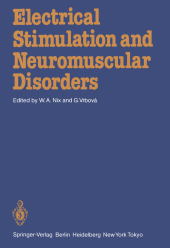 Neuerscheinungen 2012Stand: 2020-01-07 |
Schnellsuche
ISBN/Stichwort/Autor
|
Herderstraße 10
10625 Berlin
Tel.: 030 315 714 16
Fax 030 315 714 14
info@buchspektrum.de |

Wilfred A. Nix, Gerta Vrbova
(Beteiligte)
Electrical Stimulation and Neuromuscular Disorders
Herausgegeben von Nix, Wilfred A.; Vrbova, Gerta
Softcover reprint of the original 1st ed. 1986. 2012. ix, 147 S. 7 SW-Abb., 9 Tabellen. 244 mm
Verlag/Jahr: SPRINGER, BERLIN 2012
ISBN: 3-642-71339-4 (3642713394)
Neue ISBN: 978-3-642-71339-2 (9783642713392)
Preis und Lieferzeit: Bitte klicken
In many cases of neuromuscular disorders the physician is faced with a complete lack of therapeutic approaches. This helplessness places the doctor in a position of conflict between his desire to help and his awareness that there is no treatment. In this situation it is tempting to indiscriminately use any procedure that avoids an admission of medical helplessness while satisfying the patient´s demand for treatment. Electrical interventions are often used to avoid this situation. Due to the random use of therapeutic approaches it is not known what really happens. Presumptions and biased empirical observations have led to the exten sive use of different forms of electrical stimulation regimes in neuromuscular diseases. Due to this unsatisfactory situation it is necessary to know more about appropriate methods that are being used in particular disorders. The search for a better understanding of nerve-muscle interaction has shown that certain activity patterns can influence muscle. These experi mental results provide a rational basis for a possible therapeutic use of electrical stimulation of nerve and muscle. Previously most research has been conducted in normal tissue, and little is known regarding the re sponses of diseased muscle. In an interdisciplinary approach to this, it is our intention to present the current knowledge about basic principles of electrical stimulation in normal muscle. Before electrical stimulation can be accepted as a therapeutic tool, we felt it necessary to summarize the effects of activity in normal and diseased muscle and nerve.
I. Effects of Nerves on Muscle.- The Role of Activity in the Development of the Mammalian Motor Unit.- Skeletal Muscle Adaptation in Response to Chronic Stimulation.- The Effect of Long-Term Electrical Stimulation on Capillary Supply and Metabolism in Fast Skeletal Muscle.- The Acetylcholine Receptor and Neural Control of Its Distribution.- Factors Influencing Motor Nerve Growth.- II. Repair Processes in the Peripheral Nervous System.- Neural Activity and the Reorganization of Motor Units in Reinnervated Skeletal Muscle.- Electrical Activity in Injured Peripheral Nerves.- Assessment of the Regenerative Capacity of Peripheral Nervous System: Enhancement of Sprouting Capacity by Exogenous Gangliosides.- Effects of Activity on Restorative Processes in the Autonomic Nervous System.- III. Muscle Plasticity in Disease.- The Role of Passive Stretch in Retarding Muscle Atrophy.- Stimulation of Denervated Muscle. What Do Isometric and Isotonic Recordings Tell Us?.- Effect of Electrical Stimulation on Denervated Muscle.- Effects of Electrical Stimulation on Normal and Diseased Human Muscle.- Treatment of Idiopathic Scoliosis with Daily Short-Term Electrostimulation.


